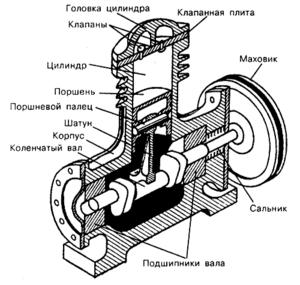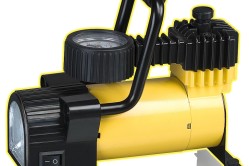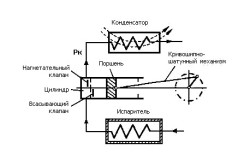You will need
- - set of wrenches;
- - Screwdriver Set;
- - oil of the corresponding brand;
- - rags;
- - container for draining mining;
- - wide brush;
- - gasoline A-92.
Instruction
The first oil change in the compressor is carried out after a short “run” of the unit, during which the piston system is lapped. Usually it is about 50-100 hours of work. Each subsequent oil change depends on the service life of the device, also expressed in hours. The specific duration of the intervals between oil changes is set by the manufacturer. Reciprocating compressors must not use machine oil. Typically, compressors are filled with special compressor oil of the KS-17 or KS-19 brands, it is possible to use foreign analogues, for example, Shell Corena D46 or Mobil Rarus.
The manufacturer's recommendations are limited to draining used oil and filling in new oil, while for compressors it is simply necessary to periodically clean the chamber of the connecting rod and piston mechanism from microscopic chips and residues of old oil accumulating in it. Preparing the compressor for an oil change consists in preheating it and draining the waste. If there is no drain plug, you will need to unscrew the level control eye and drain the oil through it, while tilting the compressor itself. Keep the filler neck open when draining the oil.
In most compressor models, the connecting rod compartment has a removable cover mounted on a paronite gasket or sealant. The cover is attached with several bolts that need to be unscrewed. When removing the cap, a small amount of oil may leak out, so always keep a container for draining at hand. cover, inner surface the chambers and the mechanism itself should be cleaned with a regular brush dipped in gasoline. When the contamination is removed, the cleaned surfaces should be wiped with a dry cloth, then the camera cover should be replaced.
Before adding new oil, clean the air filter and check valve. They are usually a cylinder mounted on top of a mechanical chamber. Foam rubber filters are usually used, which can be cleaned with gasoline. Cardboard filters, which are not as widely used, are cleaned by blowing. The filter housing, ball and check valve seat must also be washed in gasoline and dried.
Fresh oil should be poured through a special neck, in which a dipstick can be additionally installed to measure the oil level. Lubrication should be poured to a normal level, you can check the amount of leaked mining. After changing the oil, it needs to be allowed to stand for about an hour so that excess air comes out, after which the compressor can be turned on.
There are a huge number of tools that work with air compressors, due to this, high power is achieved at a very small sizes equipment.
Air compressors are divided into and, which in turn can be oil and oil-free. It must be remembered, like any equipment air compressor needs maintenance.
If we consider oil-based compressors, then the main point in their maintenance is regular oil changes. After all, clean oil is the key to long and unpretentious operation of the compressor. Therefore, many are concerned about the question: What kind of oil to fill in the air compressor?»
According to the regulations, an oil change is required every 300 hours, and for the first time in the interval from 50-100 hours. There is also an unscheduled replacement of the oily liquid, for example, if the oil has a white precipitate, then water has entered, and if the oil has turned black, it is evidence that it has overheated.
It is also necessary to remember about the maintenance of the oil filter installed in the housing. It is a sponge that needs to be washed with warm soapy water, dried and moistened with oil before installation.
- It is not recommended to mix lubricants various manufacturers;
- Use only high quality oils declared by the compressor manufacturer;
- Do not open the oil filler neck when there is pressure in the compressor;
- Dispose of only in a specially designated place.
The oil level can be checked using a special dipstick or through the glass of the oil sump.
Important! If the oil level is low, the compressor may jam, and if the oil level is too low, the air lines may become clogged.
Our company is the largest supplier of air compressors and accessories for them. For questions related to compressors and oil for them, our experts will provide you with professional advice.
In order to facilitate the movement of substances during execution production processes and domestic work, use high-pressure devices under the general name compressors. For industry, manufacturers produce a line of rotary (screw) compressors of different pressure levels - 5-12, 30-50, 150-300 bar, and for domestic and semi-industrial use - reciprocating.
Air piston compressors are divided into oil-free and oil. Oil free are used in medicine, pharmaceutical production and for domestic painting work.
compressed air in oil compressor installations are used for inflating inflatable products; refilling gas cylinders; for simplification of process of a car wash and on tire works. Air piston compressors blow through locks, car engines, heating pipes. They are used to operate pneumatic tools and refrigeration equipment.
Lubrication of air compressors
For trouble-free operation of oil-based air compressors, uninterrupted lubrication of rubbing parts is necessary, which is provided according to two schemes:
- Circular lubrication system of movement mechanism consisting of a crankshaft, bearings and a crosshead. This lubrication mechanism is provided by two gear pumps - starting and working, in front of which there is a pressure tank with a filter and a cooling coil. It is in this tank that special oil must be poured. Waste oil flows into a special receiver tank through special holes in the lower part of the compressor frame.
- Lubrication system for hydraulic seals of oil seals and cylinders. To ensure this system, 1 of 3 methods is used: a) crater oil spray, b) the introduction of atomized oil into the intake air stream, and, optimally, c) the supply of oil under pressure to the working surfaces of the seals and cylinders.
Compressor oil not only lubricates the parts of the internal mechanism, but also provides the necessary sealing of the gas compression chamber.
Oils for air piston compressors
In addition to technological necessity, the use quality brands compressor oil will provide:
- long, highly efficient machine life and longer service intervals;
- reduction of carbon deposits and varnish formation;
- safety overhead lines compressor from exothermic reactions in carbon deposits;
- anti-corrosion, deaeration, foam and wear-resistant protection of metal surfaces.
Groups
 Compressor oils for reciprocating compressors classified according to their purpose into 4 groups:
Compressor oils for reciprocating compressors classified according to their purpose into 4 groups:
- Discharge temperature (T) less than 160 °C, with moderate air-in-oil compression.
- The temperature is less than 180 °C.
- Discharge temperature less than 200 °C, heavy duty.
- Temperatures over 200 °C, with particularly difficult working conditions.
Choice
For lubrication of compressor parts operating on the basis of compressed air, oil products produced according to or corresponding to GOST 1861–54 are used.
When choosing brands of oil, first of all, you should focus on lubricity index, as the main of the characteristics of lubricating fluids. The lubricity index characterizes the adhesion of oil to metal surfaces inside the compressor and the formation of a strong protective film. Oiliness directly indicates the range of conventional temperatures in which the oil product passes from a liquid to a solid state.
- K19 and KC19 - with low sulfur content for units using medium and high level pressure;
- K2-24, K3-20, K4-20 and K2-220 - with a single lubrication system for the movement mechanism and cylinders (seals), with the possible addition of multi-purpose additives, for heavily loaded compressor piston systems with high pressure;
- K3-10 and K3-10n - with a limiting air mixture discharge temperature up to a maximum of 200 ° C, with possible composite antioxidant and other additives.
Marking and international standards
![]() for example, brand KS-19p, where: K - oil product for compressors; C - the product is produced from sour oils; 19 - oil group; p - additional additive.
for example, brand KS-19p, where: K - oil product for compressors; C - the product is produced from sour oils; 19 - oil group; p - additional additive.
In the case of K3−10n: 10 indicates the kinematic viscosity of the oil at 100 ° C, and n indicates the addition of an additive that lowers the pour point.
In the general technical world language DIN (German Institute for Standardization), compressor oils are designated as DIN 51506 ISO 6743/3 and are accompanied by an additional designation characterizing the degree of tension:
- VB or VB-l; DAG - discharge end temperature up to 140 °C (all types of compressors);
- VC or VC-l; DAA - end temperature up to 160 °C (stationary units) and up to 220 °C (mobile, mounted on vehicles);
- VD or VD-l; DAB - final compression temperature up to 220 °C (stationary and mobile compressor units). The letter l indicates the addition of additives.
Treat with care environment! Do not drain waste oil products, but hand them over to special disposal points.
Piston compressors are designed for pumping a variety of gases or liquids. The principle of operation of the compressor is based on a periodic increase in pressure in the working chamber due to the movement of the pistons. Accordingly, the quality of the compressor directly depends on the state of its moving elements, which is due to increased attention to oil selection.
What is the difficulty here?
The main problem of reciprocating compressors is maintaining the cylinders in which the main working process takes place in proper condition. Despite the fact that oil is necessary for lubrication of other elements (crankshaft, for example), it is the type of cylinders that determines the choice in favor of one or another brand of oil.
The tasks of lubricating oil are as follows:
- seal the compression chamber (this will increase the efficiency of the compressor);
- protect metal elements from corrosion;
- reduce friction (which will also increase efficiency);
- reduce wear rate.
The main load on the lubricating film falls on the upper and lower points of the cylinder - this is where the film can break. In addition, the oil in the cylinders is constantly exposed to high temperatures and high pressure.
Due to the fact that the quality of the oil film is directly dependent on the purity of the oil, it is recommended that only purified substances be pumped through the compressor. Otherwise, impurities in the form of microparticles will settle on the oil film, leading to accelerated wear of all compressor elements.
What kind of oil to fill in a piston compressor?
For the lubrication of reciprocating compressors, mineral-based oils are used in accordance with the classification DIN 51 506. As a rule, such oils are called “compressor oils”. Among Russian brands, KS-19 compressor oil is the most popular.
At the same time, small mobile compressors are often lubricated with engine oil. However, this practice is not always justified:
- Compressor oil has a high flash point, which makes the replacement of motor counterparts not entirely complete;
- Also, compressor oil is cheaper than almost any motor oil, so it only makes sense to replace it if you already have motor oil and do not need to buy it.
What are the main parameters of the oil should be of interest to us?
When choosing a compressor oil, 2 parameters are considered to be the main ones: viscosity and ignition temperature. Optimum oil viscosity for reciprocating compressor- about 20 cSt (centistokes) at a temperature of 100 degrees. The ignition temperature must be at least 230 degrees, since when the volume of the working chamber of the cylinder is compressed, the temperature can increase very significantly.
The amount of oil required for the operation of the compressor depends on its model, power and other parameters. The optimal oil volume is indicated in the technical documentation of the compressor, and it is highly recommended not to ignore this indicator.
- Air Compressor Services
When choosing oil for a compressor, every motorist must take into account that the machine is a complex mechanism, and for its competent Maintenance certain knowledge is required. Before deciding which oil to fill in the compressor, you need to understand some of the technical basics of its structure and functioning. The issue of increasing the power characteristics of the motor is one of the main ones that automakers set for themselves.
Compressor oil serves as a lubricant to reduce friction of parts, and also performs thermoregulation, providing the necessary temperature conditions.
Automotive Compressor Features
There are two solutions to the problem. The first is the production of an internal combustion engine (ICE) with a large internal volume. Such units are quite productive, but they are large and expensive to maintain.

The main task car compressor consists in the supply of air or gases under pressure.
Second and most suitable option- building a motor optimal sizes and maximum efficiency. This can be achieved by increasing the air supply to the combustion chamber of the internal combustion engine using special equipment - an air compressor.
According to the definition, this is a unit capable of creating a pressure at the inlet that exceeds atmospheric pressure. In the automotive industry, this is used to increase the power of the internal combustion engine. The compressor is added to the intake system of the machine in order to increase the air supply to the internal combustion engine, which contributes to the additional flow of fuel into the cylinders and, as a result, an increase in power vehicle.
There are several types of devices that differ from each other in design features and technical specifications, but the principle of operation is approximately the same. For example, the purpose of an oil compressor is to create pressure in the lubrication system.
Back to index
How to choose the right air compressor fluid?
Having dealt a little with the device of the unit, you can proceed to the next question. What oil to pour into the compressor for productive work and what functions does it perform? The search for an answer to it is updated with the advent of cold winter when all parts and assemblies of the vehicle are subject to increased load and the compressor is no exception. From a scientific point of view, compressor fluids are a synthetic or mineral compound. Their functions are:

- Improving the impermeability of air compression chambers.
- Reduced wear and friction of contacting elements.
- Heat sink.
The rules for the care and diagnostics of this equipment are usually prescribed in the service documentation, which indicates the permissible oil level, as well as how the oil in the compressor is changed and what liquid to fill in.
If for some reason this information is not available, you can use general recommendations regarding the choice of oil:
- If the car was produced before 1993, then it is most likely equipped with a KTS with an R12 type “cooler”. In this case, a mineral-based oil with good fluidity is used. Fills the entire working volume, reduces mechanical wear of parts.
- Cars manufactured before 1995 are equipped with the R134A unit. These compressors use PAG type oil.
- In the event that the car was initially filled with R12 fluid with subsequent conversion to R134A, it is recommended to use POE compressor oil with esters. It is important to take into account that PAG oil could have been initially filled in such a unit, therefore, in order to avoid damage, it is recommended to “flush” the compressor.
Having determined the type of oil, you need to determine its viscosity level, which is one of the main characteristics that affect the wear of compressor parts. For example, if the liquid has insufficient viscosity, it simply will not have time to cool the necessary elements. Since 1993, when PAG and POE fluids began to be used, it became necessary to change the viscosity of the oil (before that, compressor oils with the same viscosity were always filled). In the case of PAG, the indicator is 45 or 150, for POE a viscosity of 100 is provided.

Important! If you do not know what liquid is filled in the compressor, contact a specialist who will replace it before buying it. Incorrect maintenance of the compressor is fraught with damage.
Compressor oil must have the following characteristics:
- High sealing properties. The effect is achieved by oil with an optimal level of viscosity. It is necessary to fill in a liquid that fills the entire working volume with the active parts of the unit.
- High resistance to oxidation. If given property is not present, high temperatures will cause coke formation and, as a result, an explosion may occur.
- Water resistant. During compressor operation, gas may release liquid. Oil prevents it from getting on the parts of the unit.
- Resistance to gas dissolution. If the property is missing, the oil will absorb gas, thereby reducing its viscosity. Because of this, the load on the parts of the unit will increase.
Compliance with all rules and regulations, as well as following the right advice protect equipment from premature failure and prolong its service life.











Chicken in kefir - recipes for marinated, stewed and baked poultry for every taste!
Simple Chicken Recipe in English (Fried) Recipes in English with translation
Chicken hearts with potatoes: cooking recipes How to cook delicious chicken hearts with potatoes
Recipes for dough and fillings for jellied pies with mushrooms
Stuffed eggplant with chicken and mushrooms baked in the oven with cheese crust Cooking eggplant stuffed with chicken